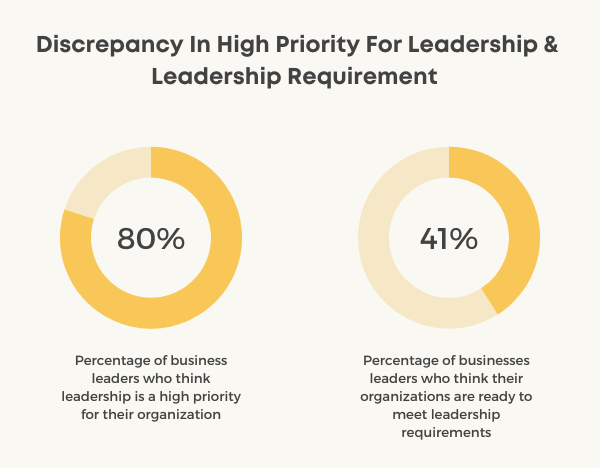Leadership training helps organizations prepare individuals for leadership roles.
While some have prominent leadership skills and natural talent for it, some need the training to define those skills and bring them forward.
With leadership training, participants will be ready to showcase their improved skills and competencies and prepare action plans. Moreover, they will also show their influence on the employees and how they are doing their job. All of this can help achieve better results for the organization.
So now that we know how important leadership training is, let’s find out about leadership training statistics.
Key Leadership Training Statistics (Editor’s Pick)
- $370 billion are invested in leadership training globally.
- Out of all managers, 58% did not receive any leadership training.
- Men are 13% more likely to receive leadership training.
- Trained public sector managers are 88% more productive.
13 Leadership Training Statistics
1. In 2019, $370 billion globally were invested in leadership training.
The training industry attracts a lot of money worldwide. For instance, in 2019, $370 billion were invested in it. The year before, in 2018, it was $366 billion. Out of those $370 billion, $169 billion comes from the US, which is almost half. In 2020, $357 billion were invested globally, and $165 billion in the US.
Source: Training Industry
2. Four in 10 business leaders report their companies are ready to meet leadership requirements.
According to Global Human Capital Trends 2019, 41% of leaders believe their organizations are ready to meet their leadership requirements. On the other hand, 80% of business leaders said that leadership was a high priority for their organization. It turns out not everyone is ready to meet their high priorities yet.
Source: Deloitte


3. Participants in leadership training improve their performance by 20% and learning capacity by 25%.
When taking leadership training, participants can improve their performance by 20% and their learning capacity by 25%. In leadership training, participants are taught theory and practice. Moreover, they can get a lot of real-life examples to implement in the workplace.
Source: Journal of Applied Psychology
4. Companies with an inclusive approach to leadership training are 4.2 more likely to outperform companies that limit leadership development to management only.
When companies allow management only to participate in leadership training, they are less likely to perform better. On the other hand, companies with an inclusive approach to leadership training are 4.2 more likely to outperform those. This data is from the Global Leadership Forecast 2018.
Source: DDI
5. Around 58% of managers did not receive any leadership training.
According to a 2018 study by CareerBuilder, 58% of managers did not receive any leadership training. However, for better overall performance, companies should start offering leadership training to managerial levels, as well as other levels.
Source: CareerBuilder
6. Nearly 60% of managers who supervise up to two employees received no leadership training.
Around 59% of managers who oversee up to two employees received no formal leadership training. In comparison, out of those who manage three to five employees, 41% of managers did not receive any type of leadership training, either.
Source: West Monroe
7. When they receive leadership training and executive coaching, public sector managers are 88% more productive.
According to Science Direct, public sector managers can become more productive with leadership training. Once they receive their leadership training and executive coaching, managers working in the public sector are 88% more productive.
Source: Science Direct


8. One in four managers says leadership training has a direct impact on business outcomes.
Around 25% of managers believe that leadership training helps their companies achieve positive business outcomes. Among positive outcomes, leadership training can influence revenue, employee retention, talent acquisition, and engagement rates.
Source: Guide2Research
9. Compared to women, men are 13% more likely to receive leadership training.
According to DDI research on 15,000 leaders, men receive leadership training more often than women. Moreover, DDI report that men are 13% more likely to receive leadership training.
Source: DDI
10. By 2024, the leadership training market is expected to grow by $26.7 billion.
In the next three years, the leadership training market should grow by an estimate of $26.7 billion. According to Technavio, companies are expecting that leadership training will help them revive their businesses after the COVID-19 impact.
Source: Technavio
11. Leadership training increases leadership behavior by 28%.
According to the leadership training statistics, training increases leadership behavior by 28%. However, without leadership training and preparation for a leadership role, employee turnover and mistakes are more common.
Source: Journal of Applied Psychology


12. Around four in 10 managers developed their leadership style through observation only.
As it turns out, not every manager gets the proper education and training to develop a leadership style. Moreover, 42% of managers developed their leadership style through observing previous managers. This means that they received no formal training for their managerial role.
Source: West Monroe
13. Only 30% of organizations are effectively developing leaders to meet the challenges of 21st-century leadership.
While 80% of the respondents to Deloitte’s research believe that leadership in the 21st century has different challenges and requirements, only 30% say their organizations are training leaders to meet these challenges. Some of these requirements and challenges include fairness, inclusion, and social responsibility. Likewise, only one in four (25%) of respondents said that their organizations are effectively building digital leaders.
Source: Deloitte
Final Verdict
In conclusion, leadership training statistics can tell us how important it is for companies to offer leadership training to their staff and managers. Moreover, leadership statistics also notify us of the positive effects training has on the business. Also, leadership development statistics should help organizations learn that development programs have a lot of benefits, too. Finally, leadership qualities will help individuals rise on the corporate ladder towards management and C-level positions.


































Find Us on Socials